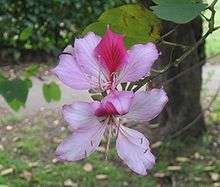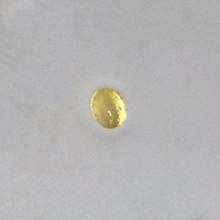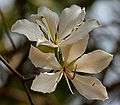Bauhinia variegata
Bauhinia variegata is a species of flowering plant in the legume family Fabaceae. It is native to an area from China through Southeast Asia to the Indian subcontinent.[2] Common names include orchid tree (though not belonging to the family Orchidaceae) and mountain ebony.[2]
| Bauhinia variegata | |
|---|---|
 | |
| Flowers | |
| Scientific classification | |
| Kingdom: | Plantae |
| Clade: | Tracheophytes |
| Clade: | Angiosperms |
| Clade: | Eudicots |
| Clade: | Rosids |
| Order: | Fabales |
| Family: | Fabaceae |
| Genus: | Bauhinia |
| Species: | B. variegata |
| Binomial name | |
| Bauhinia variegata | |
| Synonyms[1] | |
| |
Description
It is a small to medium-sized tree growing to 10–12 metres (33–39 ft) tall, deciduous in the dry season. The leaves are 10–20 centimetres (3.9–7.9 in) obcordate shaped, long and broad, rounded, and bilobed at the base and apex. The flowers are conspicuous, bright pink or white, 8–12 centimetres (3.1–4.7 in) diameter, with five petals. Pollens are elongated, approximately 75 microns in length.

The fruit is a seedpod 15–30 centimetres (5.9–11.8 in) long, containing several seeds. The seedpod dries completely on the tree, and when mature begins to twist into a helix or corkscrew shape, (see below), ultimately exploding open—with a very audible "clack"—to deliver its seeds into the environs.
The anatomy of the stem was studied by taking transverse section. Periderm and cortex were seen distinctly. Secondary phloem was wide and continuous cylindrical, it consisted of thin and narrow straight rays, three or four cylinders of discontinuous masses of fibres and randomly distributed sieve elements. Secondary xylem was diffuse porous and it included vessels, fibres, xylem rays and xylem parenchyma. Xylem fibres had thick lignified walls or some had gelatinous walls. Xylem parenchyma cells were abundant in the xylem. Xylem rays were one cell wide; they were straight and consisted of radially elongated thick walled lignified walls. Calcium-oxalate crystals are predominantly prismatic crystals and druses type. Powder microscopical examination showed presence of fibres, parenchymatous cells, periderm and vessel elements. Histochemical analysis of stem showed presence of protein, tannin, lignin and cellulose.[3]
The anatomy of the root was studied by taking transverse section. Secondary phloem and secondary xylem were seen distinctly. Secondary phloem had fairly wide rays, dense masses of phloem fibers and radial rows of phloem elements. Secondary xylem had much wider, thin-walled vessels which were either solitary or in radial multiples. The xylem fibers constituted gelatinous type and normal type. Calcium oxalate crystals were predominantly prismatic type. Powder microscopical examination showed presence of xylem parenchyma cells, xylem fibers and vessel elements.[4]
In cultivation
This is a very popular ornamental tree in subtropical and tropical climates, grown for its scented flowers and also used as a food item in Indian cuisine. In the Neotropics, it can be used to attract hummingbirds—such as sapphire-spangled emerald (Amazilia lactea), glittering-bellied emerald (Chlorostilbon lucidus), or white-throated hummingbird (Leucochloris albicollis)—into gardens and parks.[5] On the other hand, in some areas it has become naturalised and invasive.
Gallery
Uses as food & Medicine
Kachnar is a local name in India and Pakistan for the edible buds collected from the tree; it is widely used as an ingredient in many subcontinent recipes. Traditional kachnar curry is prepared using kachnar buds, yogurt, onions and native spices. Kachnar buds are also eaten as a stir-fried vegetable and used to make achaar, a pickle in many parts of the Indian sub-continent. In some regions it is cooked with minced beef.[6] It shows a good antioxidant and anticancer activity.[7]
References
- "Bauhinia variegata". International Legume Database & Information Service (ILDIS). Retrieved 24 April 2019.
- "Bauhinia variegata". Germplasm Resources Information Network (GRIN). Agricultural Research Service (ARS), United States Department of Agriculture (USDA). Retrieved 23 April 2019.
- Pharmacognostical Studies of Bauhinia variegata Linn., stem. Patel L D., Golwala D.K.International Journal of Pharmaceutical Research (IJPR) (ISSN Online: 0975-2366), Surat, India. 2012: Volume 4, Issue 3, page: 127-130.
- Pharmacognostical studies of Bauhinia variegata root. LD Patel and DK Golwala, Journal of Young Pharmacist (JoYP) (ISSN Print: 0975-483, Online: 0975-1505), Bangalore, India. 2009: Volume 1, Issue 1, page: 36-41.
- Baza Mendonça, Luciana; dos Anjos, Luiz (2005). "Beija-flores (Aves, Trochilidae) e seus recursos florais em uma área urbana do Sul do Brasil [Hummingbirds (Aves, Trochilidae) and their flowers in an urban area of southern Brazil]. [Portuguese with English abstract]" (PDF). Revista Brasileira de Zoologia. 22 (1): 51–59. doi:10.1590/S0101-81752005000100007.
- "Kachnar - a versatile plant tree". Technology Times. 17 May 2015. Retrieved 29 March 2020.
- Antioxidant and Antimutagenic (Anticlastogenic) activity of alcoholic extract of Bauhinia Variegata Linn Root. Dharmesh K. Golwala, Santoshkumar Vaidya, Kishore Dholwani, Darpini S. Patel and Satyajit Sahoo. European Journal of Medicinal Plants (ISSN: 2231-0894) 2020: Volume 31, Issue 2, page: 32-39.
External links
Bauhinia variegata in West African plants – A Photo Guide.
| Wikimedia Commons has media related to Phanera variegata. |



.jpg)